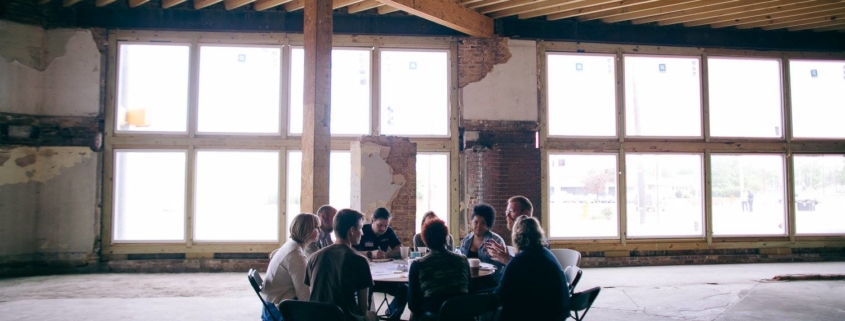The Next Big Thing Urbanism Workshop Recap
On April 23 of this year, Glass House Collective hosted an urbanism workshop in the former Alabama Furniture building on Glass Street. At nine o’clock that morning, the ground floor was flooded with natural light as it began to fill with people: architects, designers, park planners, and artists; teachers, store-owners, photographers, and neighbors. Armed with coffee cups and complimentary pastries, they came to share their ideas and concerns with each other. They came ready to make a difference.
Inspired by the Kickoff presentation the night before, attendees split into nine teams, each equipped with two facilitators: one from Chattanooga or the surrounding area and one from out of town. The groups sat at round tables equipped with poster boards, sticky notes, maps of the Glass Street neighborhood, and plenty of pens. Before taking to the streets, most began with introductions and noted each other’s specialized fields. An excited buzz of conversation marked the start of a groundbreaking day.
First, We Brainstormed!
Team One, led by Kristin Jeffers and Justin Tirsun, was given a prompt: “I want ______ in my neighborhood.” The blanks were filled with things like “Participation,” “Great places to walk,” and “a dance studio.” Facilitator Chooch Pickard of Team Six was a major inspiration for Glass House Collective’s wildly successful “Better Block” project in June 2013, which promoted pop-up shops and vendors, along with temporary artwork and dancing. This year, he stated that his interests lay in the residential fabric of Glass Street, “off the main path,” marking spots on the Glass Street map that he felt needed special attention.
Team Three was interested in “connecting to the core area,” feeling that there was a need to reinforce a sense of place at Glass Street’s main crossroad, drawing out ideas straight onto the map as well as in their notebooks.
Taking it to the Streets
Next, the teams headed outside for a walkabout Glass Street. They headed up and down allies as well as the main roads, surveying places with potential and chatting with shop owners and neighbors. A member of Team Three and resident of Glass Street pointed out The New Church of God’s renovations on the main strip as an example of how community work “really brightens up the neighborhood.”
A member of Team Nine led the other members down North Chamberlain Street, just off Glass Street. Her dog bounded up to the edge of her fence, the members taking turns petting her while Gail McKeel pointed out parking issues in front of her house. She also mentioned that the children ages 13-15 really needed a place to hang out after school without getting harassed by older teenagers or having to walk far from home.
Team Five was concerned with the closest supermarket being a ten-minute drive from the center of Glass Street. They looked into street lighting and sidewalk improvements as tools for travel, as well as addressing the lack of places to walk dogs. They also talked about ways to turn the streams and large gutters from “a problem to an asset.”
Looking Ahead
As the teams ventured back inside for lunch, they began placing their ideas down on paper. They organized projects into three groups: changes that could be implemented in one month, one year, and three years. Ideas ranged from “Light up the Porch” home improvement projects to swinging benches, from bike paths to “Architect for a Day” pop-up centers. It was such a rush to see these creative, scalable, realistic ideas put on paper, with so many overlapping concerns but also innovative designs and genuine care being manifested at the round tables. For the rest of the day and into the evening, the teams put together thoughtful and inspirational presentations of their ideas to share at the Design Showcase on Thursday, April 24. Team presentations, sketches, and one page summaries can be found here.
Written by: Isobel Ward







Leave a Reply
Want to join the discussion?Feel free to contribute!